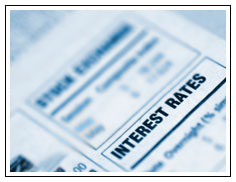Provided to you Exclusively by Eve Robin Jarrett

For the Month of October 2009 — Vol. 4, Issue 10
IN THIS ISSUE… ![]()
It’s My Life… It’s Now or Never! The lyrics from Bon Jovi’s hit song say it all. This month’s edition is all about understanding and taking advantage of opportunities now… before it’s too late.
You’ve probably heard a lot about the $8,000 tax credit for first-time homebuyers. But did you know the $8,000 tax credit is about to end? The first article below provides details about the tax credit that you need to know. Another opportunity you don’t want to miss is a low interest rate. Interest rates have dipped near historic lows, but the second article below explains how you can avoid a costly mistake when it comes to rates.
This information is important for anyone who has even thought about purchasing a home or refinancing. So please forward this newsletter to friends, family members, and coworkers who may benefit from this information. And if you need any assistance at this time, just call or email.
This information is important for anyone who has even thought about purchasing a home or refinancing. So please forward this newsletter to friends, family members, and coworkers who may benefit from this information. And if you need any assistance at this time, just call or email.
$8,000 Tax Credit Nears End ![]()
 The government is offering an $8,000 tax credit for first-time homebuyers – that is, folks who haven’t owned a home during the past three years. According to the plan, first-time homebuyers who purchase a home may be eligible for the lower of an $8,000 or 10% of the value of the home tax credit.
The government is offering an $8,000 tax credit for first-time homebuyers – that is, folks who haven’t owned a home during the past three years. According to the plan, first-time homebuyers who purchase a home may be eligible for the lower of an $8,000 or 10% of the value of the home tax credit.
However, the program is scheduled to end soon. In fact, the Internal Revenue Service recently reminded potential first-time buyers that they must complete their first-time home purchases before December 1, 2009 to qualify for the special credit, which means the last day to close on a home and qualify for the credit is November 30, 2009. In other words, right now is the time to take advantage of this opportunity.
Here’s some information to help you understand what the tax credit benefits are and who qualifies.
Benefits of the Tax Credit
It’s important to remember that the $8,000 tax credit is just that… a tax credit. It’s a dollar-for-dollar tax reduction, rather than a reduction in a tax liability that would only save you $1,000 to $1,500 when all was said and done. So, if you were to owe $8,000 in income taxes and would qualify for the $8,000 tax credit, you would owe nothing.
Better still, the incentive is refundable, which means you can receive a check for the credit even if you have little income tax liability. For example, if you’re liable for $4,000 in income tax, you can offset that $4,000 with half of the tax incentive… and still receive a check for the remaining $4,000!
Who Qualifies?
The $8,000 incentive starts phasing out for couples with incomes above $150,000 and single filers with incomes above $75,000 and is phased out completely at incomes of $170,000 for couples and $95,000 for single filers. To break down what this phase-out means, the National Association of Homebuilders (NAHB) offers the following examples:
Example 1: Assume that a married couple has a modified adjusted gross income of $160,000. The applicable phase-out threshold is $150,000, and the couple is $10,000 over this amount. Dividing $10,000 by $20,000 yields 0.5. When you subtract 0.5 from 1.0, the result is 0.5. To determine the amount of the partial first-time homebuyer incentive to this couple, multiply $8,000 by 0.5. The result is $4,000.
Example 2: Assume that an individual homebuyer has a modified adjusted gross income of $88,000. The buyer’s income exceeds $75,000 by $13,000. Dividing $13,000 by $20,000 yields 0.65. When you subtract 0.65 from 1.0, the result is 0.35. Multiplying $8,000 by 0.35 shows that the buyer is eligible to reduce the tax liability by $2,800.
Remember, these are general examples. Borrowers should consult a tax advisor to provide guidance relevant to their specific circumstances.
What Type of Home Qualifies?
The tax credit is applicable to any home that will be used as a principal residence. Based on that guideline, qualifying “homes” include single-family detached homes, as well as attached homes such as townhouses and condominiums. In addition, manufactured homes and houseboats used for principal residence also qualify. Buyers will have to repay the credit if they sell their homes within three years.
Avoid This Costly Mistake ![]()
 If you’ve been following the financial news, you’ve probably heard that the Fed’s been buying Mortgage Backed Securities. Unfortunately, people have picked up on the news and mistakenly discussed how these purchases will continue to cause rates to drop lower. But is that really what it means? No.
If you’ve been following the financial news, you’ve probably heard that the Fed’s been buying Mortgage Backed Securities. Unfortunately, people have picked up on the news and mistakenly discussed how these purchases will continue to cause rates to drop lower. But is that really what it means? No.
The following information can help set the record straight and help you make smart decisions that lead to a low interest rate for your home loan.
How is the Fed’s Bond Purchase Related to Rates?
The Fed has been buying Mortgage Bonds. BUT… more precisely, they’re buying a lot of FNMA 30-yr 5.0% and 5.5% Bonds. Many of the mortgages in these pools are outstanding home loans with rates between 6.0% and 6.5%, as the rate that a borrower pays is different than the coupon rate given to an investor buying into that mortgage pool, with the difference being taken by Wall Street firms and government agencies. The loans in these pools are likely to be refinanced and paid – because current rates make it very attractive to refinance a loan over 6.0%. Thus, giving the Fed a quick recoup on some of its investment.
Bottom line: The Fed’s purchase of higher rate coupons will not necessarily help rates to move lower, as their actions do not impact the loans being originated at today’s low rates.
The Problem Is…
Many consumers are in situations where they can refinance now and save hundreds of dollars a month on their mortgage payments. But if they hear people throwing around teases of lower rates ahead, they may decide to hold off on making the decision to save, in the hopes of gaining a few more dollars of savings per month if a lower rate came their way. Of course, while they’re waiting, rates could turn higher – especially when you consider that the Fed is scaling back its purchases of Mortgage Backed Securities – and this window of opportunity could pass them by entirely.
Is the Fed Scaling Back? And What Will It Mean to Rates?
Last week, the New York Fed began to scale back their Mortgage Backed Security purchase program. The Fed has been buying about $25 Billion worth of Mortgage Backed Securities per week, but the new plan to drag out these purchases over a longer period of time means that they will be reducing both the frequency and amounts of their purchases. This will cause higher levels of volatility, as the Fed will be purchasing less often and less consistently. As a result, rates will probably rise gradually over time.
Here’s the Clincher
Even if consumers are ultimately able to time the market perfectly and save another few bucks per month, they could still end up losing. That’s because while they delayed, they lost the savings each month they could have gained by taking action sooner. In other words, they may have lost hundreds of dollars for every month they waited. So even if they got lucky and obtained the rate they were looking for, it could take years to make up what they lost by waiting.
I don’t want anyone to miss an opportunity by either waiting or misunderstanding the media headlines. Let’s talk further on this. Call or email me, and let’s discuss what this might mean for you.
The material contained in this newsletter has been prepared by an independent third-party provider. The material provided is for informational and educational purposes only and should not be construed as investment, financial, real estate and/or mortgage advice. Although the material is deemed to be accurate and reliable, there is no guarantee it is not without errors.
As your Trusted Advisor, I always want to make sure you are clear on all details of the home financing process. If you or someone you know are interested in purchasing or refinancing a home, give me a call today!
In the unlikely event that you no longer wish to receive these valuable market updates, please USE THIS LINK or email: ejarrett(at)manhattanmortgage(dotted)com
If you prefer to send your removal request by mail the address is:
Eve Robin Jarrett
Manhattan Mortgage
75 Main Street, 2nd Floor
East Hampton, NY 11937
Mortgage Success Source, LLC is the copyright owner or licensee of the content and/or information in this email, unless otherwise indicated. Mortgage Success Source, LLC does not grant to the recipient or distributor a license to any content, features or materials in this email. You may not distribute, download, or save a copy of any of the content except as otherwise provided in our Terms and Conditions of Membership, for any purpose.
